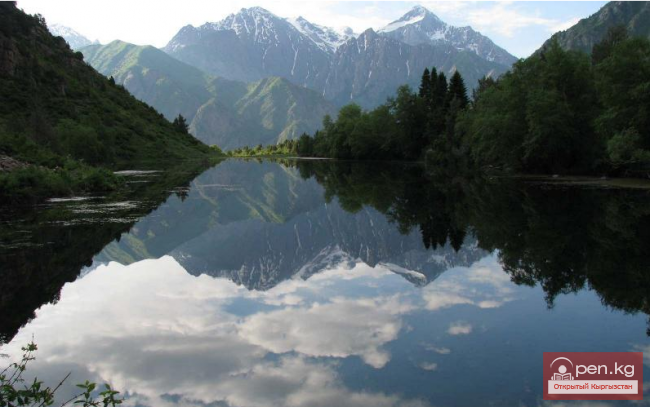Just 37 km from the city of Karakol, lies one of the most beautiful places in Kyrgyzstan - Jeti-Oguz Gorge
It is located in the floodplain of the river of the same name on the northern slope of the Terskey Alatoo range, which curves around Lake Issyk-Kul from the south. The name Jeti-Oguz (translated from Kyrgyz as "seven bulls") comes from a chain of weathered red rocks that resemble lying bulls on the ground and serve as the gorge's hallmark. A local attraction is the rock "Broken Heart," in front of which lovers always take photos.
The area is so unique and memorable that it once inspired artists to create a series of postage stamps, which have become true rarities for genuine collectors.
Jeti-Oguz Gorge is one of the most beautiful places in Kyrgyzstan, the second mountainous section of the Issyk-Kul Nature Reserve.
The climate here is continental. Winter is moderately mild, sunny, and has little snow; the average temperature in January is -9° C. Summer is moderately warm; the average temperature in July is 15° C. Precipitation is about 500 mm per year, mainly from April to October. The average annual relative humidity is about 65%. The number of hours of sunshine is 1828 per year.
Jeti-Oguz Gorge flattens into the wide Kek-Dzhaiyk valley, overgrown with magnificent coniferous forests that literally climb the vertical cliffs and fill almost the entire gorge with their gracious shade.
For almost 25 km on both sides of the gorge, Tien Shan fir trees grow.
The Tien Shan fir is truly a unique tree, with an absolutely straight trunk and a crown that resembles a cypress. The height of individual specimens reaches dozens of meters. Imagine that while walking along the slopes of the red rocks in the gaps of the mountain cliffs, you can see the tops of fir trees reaching such heights directly from the bottom of the crevices.
As you ascend higher, towards the snow-capped peak of Oguz-Bashi ("Head of the Bull"), the mountain slopes become gentler, and the fir forest spreads into an all-consuming green sea, indeed resembling the Siberian taiga.
Above the forest zone (about 3000 m), in a wide valley about 15 km wide, magnificent subalpine and alpine meadows - jailoo - are located. In the spring and summer months, Jeti-Oguz Gorge is a true festival of flowers, among which the silvery stars of edelweiss, alpine daisies, and asters, as well as elecampane (golden root) stand out. From the northern slopes of the peaks Karakol and Oguz-Bashi, the rivers Archa-Tor and Ailynash originate, forming the river Jeti-Oguz.

The left bank of Jeti-Oguz Gorge is formed by the peak Kok-Debe (2700 m), located directly near the resort, and the peaks Podkova (3500 m) and Druzhba Narodov (3800 m). Through the depressions between the peaks Kok-Bel (2600 m) and Asan-Tukum (3600 m) on this same bank of the gorge, one can descend into the neighboring Chon-Kyzyl-Suu gorge. On the right bank of Jeti-Oguz Gorge is the Kashka-Suu pass, which is located above the resort and offers an exciting journey to the upper reaches of the Yrdyk gorge and the "Karakol" zone.
The dense fir forests of the gorge, magnificent subalpine and alpine meadows - jailoo, the extraordinarily beautiful "Flower Meadow" along the Telet valley - are a true festival of flowers, and the diverse wildlife includes snow leopards, griffons and eagles, herds of swift goats, bears, wild boars, roe deer, grouse, chukars, and pheasants.
However, this picturesque corner of the planet is famous not only for its beautiful nature, relict rocks, and the associated folklore. Since ancient times, it has been renowned for its hot springs of mineral waters, whose main wealth - the radioactive gas radon - is an indispensable aid in the treatment of many diseases.
The healing properties of the mineral springs of Jeti-Oguz have been known to the local population since ancient times.
In 1857, P. P. Semenov-Tyan-Shansky made the first description of the mineral springs of Jeti-Oguz.
In 1910, organized exploitation began, wooden baths and a building for 50 people were constructed.
In the distant 1931, the construction of a balneological resort began in these places, which has been receiving visitors year-round since 1965. Today, the resort is famous for its hot baths, mud therapy, and healing drinks.

The local mineral waters are the main healing factor and are very interesting in their composition. They contain: bromine, iodine, manganese, zinc, aluminum, nickel, lead, lime, copper, as well as a biologically active component - radon, with a maximum concentration reaching 127 nCi/l.
Many medical professionals assert that the local springs are no less effective than the famous health resorts of Tskhaltubo and Pyatigorsk.
Indications for treatment with the local waters include diseases of the gastrointestinal tract, musculoskeletal system, skin diseases, and problems with the central nervous system.
About 5 km south of the sanatorium lies the Valley of Flowers, which bursts into bloom with poppies starting in May.
In the village itself, there is an ancient cemetery and several burial mounds dating from the 7th to the 5th centuries BC - today their sizes range from 16 to 28 meters in diameter and 1.7 to 3 meters in height, but they were once even larger.















































